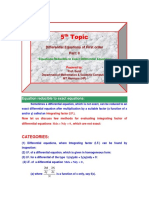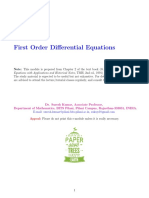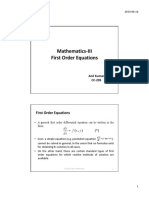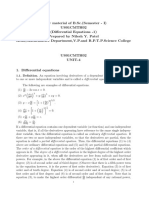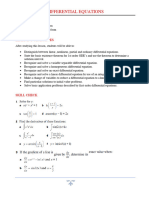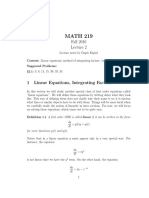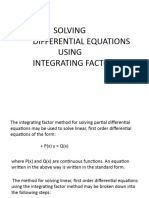CHAPTER 2.
FIRST ORDER DIFFERENTIAL EQUATIONS
2.4. Exact Di¤erential Equations
De…nition. Let F be a function of two real variables such that F has continuous
…rst partial derivatives in a domain D: The total di¤erential dF of the function
F is de…ned by the formula
@F (x; y) @F (x; y)
dF (x; y) = dx + dy
@x @y
for all (x; y) 2 D:
De…nition The di¤erential form
M (x; y)dx + N (x; y)dy (1)
is called an exact di¤erential in a domain D if there exists a function F of two
real variables such that this expression equals the total di¤erential dF (x; y) for
all (x; y) 2 D:
That is, expression (1) is an exact di¤erential in D if there exists a function
F such that
@F (x; y) @F (x; y)
= M (x; y) and = N (x; y) for all (x; y) 2 D:
@x @y
If M (x; y)dx + N (x; y)dy is an exact di¤erential, then the di¤erential equation
M (x; y)dx + N (x; y)dy = 0
is called an exact di¤erential equation.
Theorem. Consider the di¤erential equation
M (x; y)dx + N (x; y)dy = 0; (2)
where M and N have continuous …rst partial derivatives at all points (x; y) in
a rectangular domain D: The di¤erential equation (2) is exact if and only if
@M (x; y) @N (x; y)
=
@y @x
for all (x; y) 2 D:
Example. Solve the following di¤erential equations.
1)
(3x2 + 4xy)dx + (2x2 + 2y)dy = 0:
1
�Solution. We observe that the equation is exact since
@M (x; y) @N (x; y)
= = 4x:
@y @x
So, there exists a function F (x; y) such that
@F
= 3x2 + 4xy (3)
@x
@F
= 2x2 + 2y (4)
@y
Thus, from (3); we get
F (x; y) = x3 + 2x2 y + h(y) (5)
Using (4)and (5); we get
@F
= 2x2 + 2y = 2x2 + h0 (y): (6)
@y
From (6) we obtain h0 (y) = 2y and h(y) = y 2 + c1 : So, we obtain F (x; y) =
x3 + 2x2 y + y 2 + c1 and the solution of given di¤erential equation
x3 + 2x2 y + y 2 = c:
2)
(2x cos y + 3x2 y)dx + (x3 x2 sin y y) = 0; y(0) = 2:
3)
(yexy tan x + exy sec2 x)dx + xexy tan xdy = 0:
2.5. Integrating Factor
Consider the following di¤erential equation
M (x; y)dx + N (x; y)dy = 0 (1)
De…nition. If the di¤erential equation (1) is not exact but the di¤erential
equation
(x; y)M (x; y)dx + (x; y)N (x; y)dy = 0
is exact,then (x; y) is called an integrating factor of the di¤erential equation
(1).
Theorem. (i)If
My Nx
N
2
�depends on x only, then
Z
My Nx
(x) = exp dx
N
is an integrating factor.
(ii)
My Nx
M
depends on y only, then
Z
My Nx
(y) = exp dy
M
is an integrating factor.
Example. Solve the following di¤erential equations.
1)
(x2 + y 2 + x)dx + xydy = 0
Solution. Let us …rst observe that this equation is not exact. It is clear that
My = 2y, Nx = y and
My N x 1
= :
N x
So there exists and integrating factor which depends on x: Integrating factor is
calcuşated as Z
My N x
(x) = exp dx = x:
N
Multiplying equation by we obtain the equation
(x3 + xy 2 + x2 )dx + x2 ydy = 0
which is exact. Now, we have to …nd the function F (x; y) such that
@F
= x3 + xy 2 + x2 (i)
@x
@F
= x2 y (ii)
@y
Integrating (i); we get
x4 x2 y 2 x3
F (x; y) = + + + h(y) (iii)
4 2 3
Taking the derivative of (iii) with respect to y and using (ii); we obtain the
solution of di¤erential equation
3x4 + 6x2 y 2 + 4x3 = c
2)
(2xy 2 3y 3 )dx + (7 3xy 2 )dy = 0
3)
(2xy 3 2x3 y 3 4xy 2 + 2x)dx + (3x2 y 2 + 4y)dy = 0














